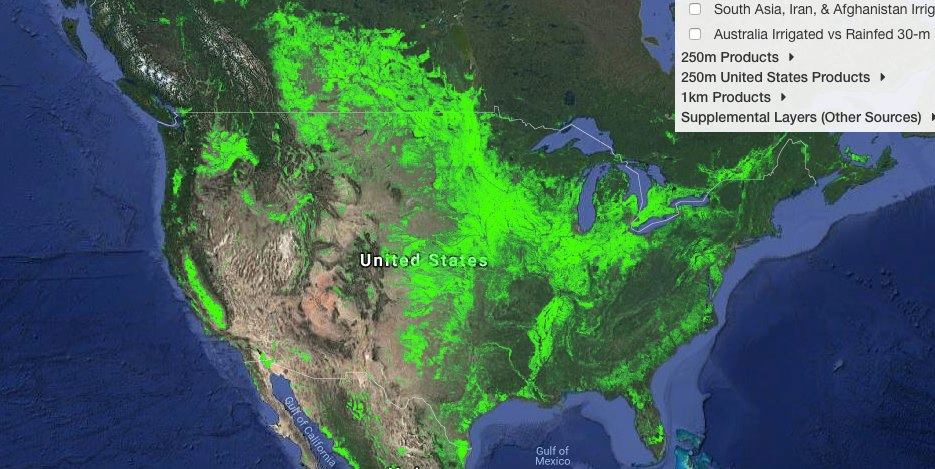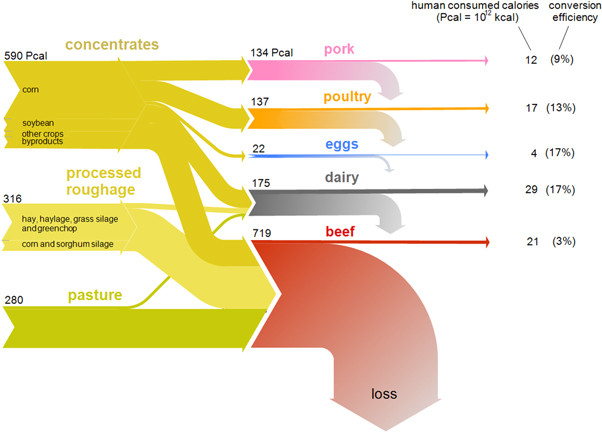The highlighted green represents U.S. Cropland, which in the Eastern half of the U.S and Southern Canada is primarily Livestock Feed Production. This does not include the land that is grazed by Livestock. Source
Did you know the majority of Ecosystem Displacement/Habitat Loss in the Eastern U.S. and Canada is due to the production of annual crops for livestock feed and ethanol production? The 40% of corn grain that is turned into Ethanol occupies is far less energy efficient than renewable energy as far as energy put in vs energy output. Some studies have even found that Ethanol is a net loss of energy.
The fat, non-yellow lines on the right half of the graph represent the loss, the skinny lines of different colors represent what we harvest for food. The source of this graph is this study linked here
One aspect about meat production that is not well known is Cows convert only 1%-3% of what they eat into human harvested food (97%-99% waste). Chickens are the most efficient of all livestock converting 11%-13% (87%-89% waste) of what they eat into human harvested food, and pigs lie between cow and chicken as far as conversion efficiency. People often surmise that cow production is acceptable because they eat grass that grows in areas where we can't productively grow crops for humans consumption. This is only the case in arid or very cold regions that do not grow much human edible food in the form of plants. But anywhere that's highlighted green is cropland capable of growing perennial or annual foods for direct human consumption.
Ironically our driest cropland grows the most human consumed food, Wheat. The most intense area of wheat production occurs in the driest region of cropland where soy and corn can’t grow as productively. Wheat production is the least wasteful as only about 10% is feed to livestock, 50% is exported to be eaten directly by humans, 4% is harvested to replant, and 36% is eaten by Americans. So the fact that wheat grows in our driest cropland region, and +85% consumed by humans, makes it our least negatively environmental impactful crop outside of corn directly consumed by humans such as sweet corn and Native American varieties of corn. The reason why Native American varieties of corn, which have never been bred to feed to livestock, would be the least impactful annual crop is due to the fact these varieties of corn would still produce more food per acre than wheat, and they are bred to be consumed directly by humans. Livestock varieties of corn are not considered desirable for human consumption.
Foods directly consumed by humans cut out the 87%-99% loss that is the cost of converting feed (corn/soy/hay/sorghum/alfalfa) into meat. Some meat conversion studies have found ratios even lower, at 1% to 11% from Cow to chicken (89%-99% Waste).
Source for conversion efficiency of feed into harvested meat (3%-13%)
Percent/Units of Edible Output per 100 Units of Feed
Poultry – Calories – 11% (89% loss)
Pigs – Calories – 10% (90% loss)
Cows/Beef – Calories – 1% (99% loss)
Source: World Resources Institute (w/UN & WB): Creating a Sustainable Food Future, p.37
Corn/Soy rotations; only 1-13% of the caloric value of these crops will be consumed by humans, at the cost of our climate stability and the former ecosystems that occupied this land. This isn’t factoring that 40% of the corn is used for ethanol production, which speaks to role renewable energy plays in efficient land use.
Let’s be fully aware of the land/ecosystem sacrifice it requires to waste 87%-99% of the crops we grow for livestock feed to harvest the 1%-13% of human harvested food in the form of meat. There is not only a nearly unimaginable biodiversity cost, but the carbon and methane released from the conversion of Savanna, Forest, Wetlands, and Grasslands into annual crop production is also major climate cost in the form of greenhouse gases. Much of the deforestation in South America in present day, is a page out of this playbook of converting ecosystems into livestock feed for meat production. Not to mention the +30% of the fish caught from our oceans are fed to chickens, pigs, and fish farms.
This post doesn’t factor grazed forest, savanna, or pasture/grassland, of which there can be more “sustainable” grazing patterns employed at a low enough stocking rate to promote some level of biodiversity. But this purely grass fed diet would still require lessened meat production and would also be a waste of land as far as calories harvested per acre in the moist Eastern half of the U.S and Southern Canada, which can grow crops directly consumed by humans due to our rainfall. The less calories we harvest per acre, the more acreage is needed for crops in a world destined for a population 10 billion people by 2050. The more acreage needed for crops or cow grazing in the eastern half of the U.S., the less opportunity for large habitat restoration.
Americans consume the 2nd most meat per person in the world, weighing in at over 270 pounds consumed per person per year. The lowest countries in meat consumption come in at 7 pounds per person per year. If we could limit our consumption to 1 pound a week, it would put us at 52 pounds per year, which is a 81% reduction. Shifting that 1 pound per week to the most efficient converters of feed, Chicken and Fish, would also minimize the land needed to produce the meat we consume. These are kind of changes needed for large scale restoration and climate change mitigation to be possible.
The best case scenario for Native Grasslands and our climate, remains the cessation of grain production for livestock feed, and large scale restoration of native prairies for Bison/Elk as opposed to grasslands managed purely for meat production. This wouldn't threaten our ability to feed ourselves, but it would require lessened consumption and lessened export of meat products. We also export grain to feed other countries livestock, at the same 87%-99% crop waste rate. Global demand is a factor that is mostly out American citizens control, but if the U.S can greatly decrease meat consumption and replace ethanol production with renewable energy production, we can free up land for large-scale grassland restoration for our native grazers, biodiversity, and for carbon sequestration. This is to say, cows are not necessary for biodiversity improvements in grasslands, bison and elk can fill that role as they have for millions of years, without human assistance, specifically in scenarios that wolves or meat harvesting plans are allowed to balance their populations.
It's impossible to holistically consider conservation and restoration without being aware of the fact that our most displaced ecosystems are not displaced out of the necessity of feeding human populations, but rather, for the commodity of meat production in the form of livestock feed and inefficient ethanol fuel production.
This is why, Indigenous Landscapes is devoted to the research, demonstration, and application of Native Plant Agriculture. Through the conversion of cropland into native edible plants, we can support an agriculture system that includes, rather than excludes nature, and helps to return some of the carbon released from our ecosystems back into the soil and woody vegetation.
For more information on this alternative for Biodiversity and Carbon Sequestration, see our website here: Native Plant Agriculture



